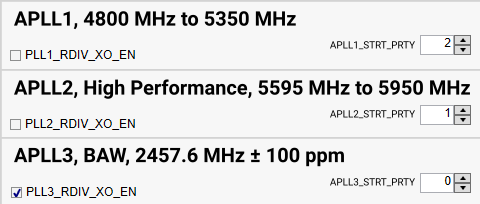SNAU295 July 2024 LMK5C33216A
- 1
- Abstract
- Trademarks
- 1Introduction
- 2EVM Quick Start
- 3EVM Configuration
-
4EVM Schematics
- 4.1 Power Supply Schematic
- 4.2 Alternative Power Supply Schematic
- 4.3 Power Distribution Schematic
- 4.4 LMK5C33216A and Input References IN0 to IN1 Schematic
- 4.5 Clock Outputs OUT0 to OUT3 Schematic
- 4.6 Clock Outputs OUT4 to OUT9 Schematic
- 4.7 Clock Outputs OUT10 to OUT15 Schematic
- 4.8 XO Schematic
- 4.9 Logic I/O Interfaces Schematic
- 4.10 USB2ANY Schematic
- 5EVM Bill of Materials
- 6Appendix A - TICS Pro LMK5B33216 Software
6.3.1 Cascaded Configurations
Cascaded configurations can be created using the input page, where the relevant VCO buffers and dividers are automatically enabled by inferring the state of source selection registers.
At least one PLL must always be active and set to XO reference source for cascaded configurations to be valid. APLL start-up priority automatically chooses XO-source APLLs to start up before all other PLLs whenever possible. Start-up priority cannot be properly inferred, therefore users must set this priority themselves in the User Controls page if in pin-selection mode. In the example below, APLL3 is referenced to the XO input and APLL1 and APLL2 are referenced from APLL3. Priority is controlled in ascending order, with 0 first and 2 last. APLLs can share priorities; if all APLL priorities are set to 0, then all APLLs starts up simultaneously.
 Figure 6-11 Cascade APLL Start
Priorities
Figure 6-11 Cascade APLL Start
Priorities